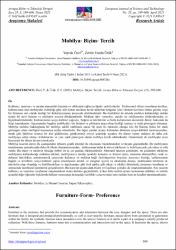Mobilya- Biçim- Tercih
Özet
Kullanıcı, tasarımcı ve mekân arasındaki iletişimi ve etkileşimi sağlayan öğeler mobilyalardır. Profesyonel ellerce tasarlanıp üretilen,
kullanıcısına özel mobilyalar olabildiği gibi, aile içinde nesilden nesile aktarılan simgesel işlevi hizmet işlevinin önüne geçmiş veya
bir firmanın seri olarak ürettiği bir koleksiyonunun parçasıda olabilmektedir. Bu özellikleri ile aslında mobilya kullanıldığı mekân
içinde bir nevi iletişim ve etkileşim aracına dönüşmektedir. Mekâna işlev vermekte, mekân içi sirkülasyonu yönlendirmekte ve
biçimlendirmektedir. Kullanıcısının sosyo-kültürel yapısını, beğeni ve tercihlerini ve hatta kullanıcının ekonomik düzeyi hakkında da
bilgi sunmaktadır. Geçmişinden bugüne mobilyalar; bir iletişim ve etkileşim aracı olma özelliği taşımış ve statü göstergesi olmuştur.
Mobilya tarihine bakıldığında bir mobilya sahibi olabilmek ancak bir statü ile mümkün olduğu için bir bakıma halen bir statü
göstergesi olma özelliğini taşımasına neden olmaktadır. Bir diğer yandan içinde bulunulan dönemin sosyo-kültürel motivasyonları,
moda gibi faktörler sonucu bir dizi güdülenmiş gereksinimin ortaya çıkardığı eşyalara bir düzen verme endişesi de daha çok
mobilyaya sahip olmayı tetiklemekte ve yine statü göstergesi olarak mobilya tercih edilmektedir. Günümüzde de mobilyalar arası
hiyerarşik bir düzen devam etmektedir.
Mobilya tasarım süreci ilk aşamasından itibaren çeşitli etkenler ile oluşmakta biçimlenmekte ve hayata geçmektedir. Bir mobilyanın
tasarlanması aşamalarında daha ilk fikrin oluşturulmasından, kullanımına kadar ki süreci etkileyen ve belirleyen pek çok etken ve etki
vardır. Bu etken ve etkilerin birçoğu birbiri ile iç içe geçmiş etkileşimlerdir. Alternatif tasarım çözümleri, bu çözümleri etkileyen
mobilyanın kullanılacağı mekânın etkileri, mobilyanın o mekân içindeki konumu ve hizmet işlevi, malzeme alternatifleri, renk ve
dokusal farklılıklar, antropometrik çerçevede kullanıcı ve mekâna bağlı farklılaşabilen boyutlar, tasarımcı kimliği, kullanıcısının
beğeni ve tercihleri, sosyo-kültürel yapısı (mobilyanın estetik ve simgesel işlevi) ve ekonomik düzeyi, mobilyadan beklenen ek
işlevlerin olup olmadığı ve histiflenebilme ve depolanması gibi özel şartlar gibi etken ve etkileri düşünürek, tasarımcı tasarlama ve
sonrasında üretilmesi işlemlerini gerçekleştirir. Bu kararlar aşamasında biçim yeri gelince yeniden de oluşturulmaktadır. Son tasarım
kullanıcı ve tasarımcı tarafından onaylandıktan sonra üretime geçmektedir. Çıkan ürün mekân içinde konumunu aldıktan ve mekân
içindeki diğer öğelerle ilişkilendirildikten sonrasında da taşıdığı özellikler çerçevesinde hem mekânı hem de kendini tanımlamaktadır. Furniture is the elements that provide the communication and interaction between the user, designer and the space. There are also
furniture that is designed and produced professionally, as well as user-specific furniture, passed down from generation to generation
within the family. Its symbolic function takes precedence over the service function or it can be a part of a company's serially produced
collection. With these features, furniture turns into a communication and interaction tool in the space. It functions the space, directs and shapes the circulation inside the space. It presents the socio-cultural structure, taste and preferences and economic level of its user.
Furniture from past to present; it has become a communication and interaction tool and status indicator. Considering the history of
furniture, acquiring a furniture is only possible by having a status. For this reason, it still has the characteristic of being a status
indicator. On the other hand, the concern of giving an order to the items brought about by a series of motivated needs as a result of
factors such as socio-cultural motivations and fashion of the current period triggers more furniture and furniture is preferred as a sign
of saturation. Today, a hierarchical order between furniture continues.
The furniture design process is formed, shaped and implemented with various factors from the first stage. There are many factors and
effects that affect and determine the process from the creation of the first idea to its use in the stages of a furniture design. Many of
these factors and effects are intertwined interactions with each other. Alternative design solutions, the effects of the place where the
furniture affecting these solutions will be used, the location of the furniture in that space and the service function, material
alternatives, color and textural differences, dimensions that can differ depending on the user and space in an anthropometric
framework, the designer identity, the user's tastes and preferences, the socio-cultural structure (the aesthetic and symbolic function of
furniture) and its economic level, whether there are additional functions expected from the furniture and special conditions, such as
stacking and storage, the designer do the design by making decisions and then start the production. In these decisions, the form is recreated and re-created. After the final design is approved by the user and the designer, it goes into production. After the product takes
its position in the space and is associated with other elements in the space, it defines both the space and itself within the framework of
its features.
Sayı
23Bağlantı
https://hdl.handle.net/11363/6065Koleksiyonlar
Aşağıdaki lisans dosyası bu öğe ile ilişkilidir:


















